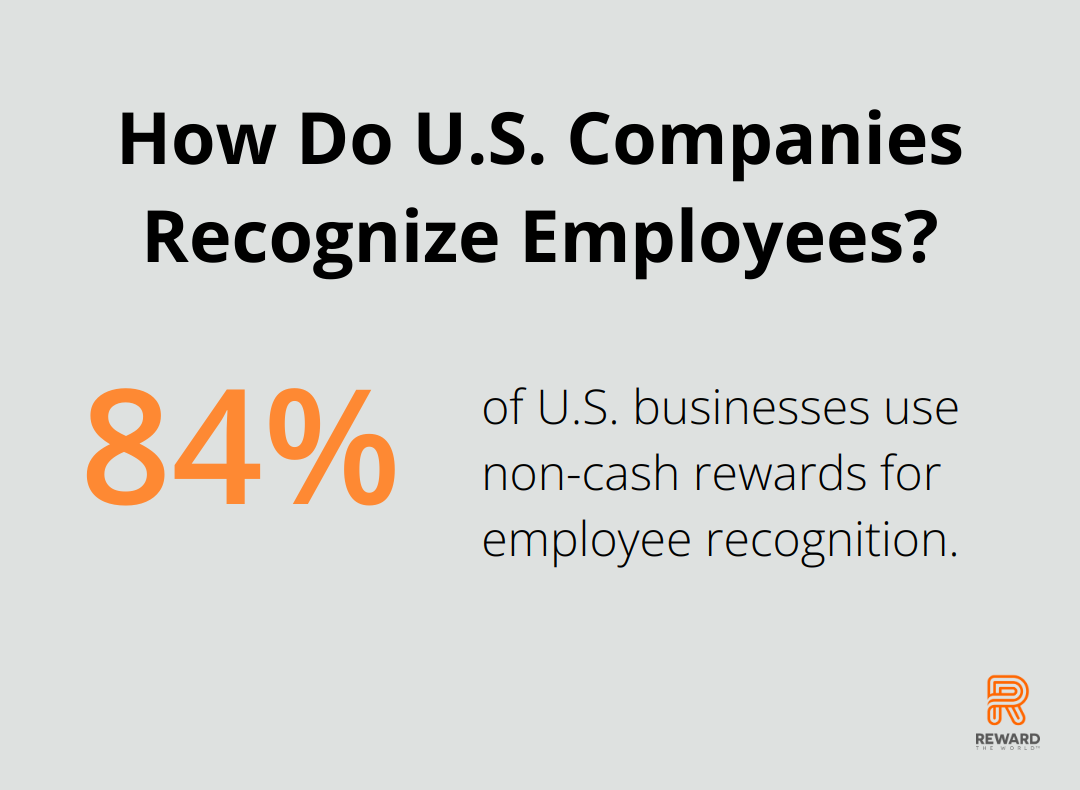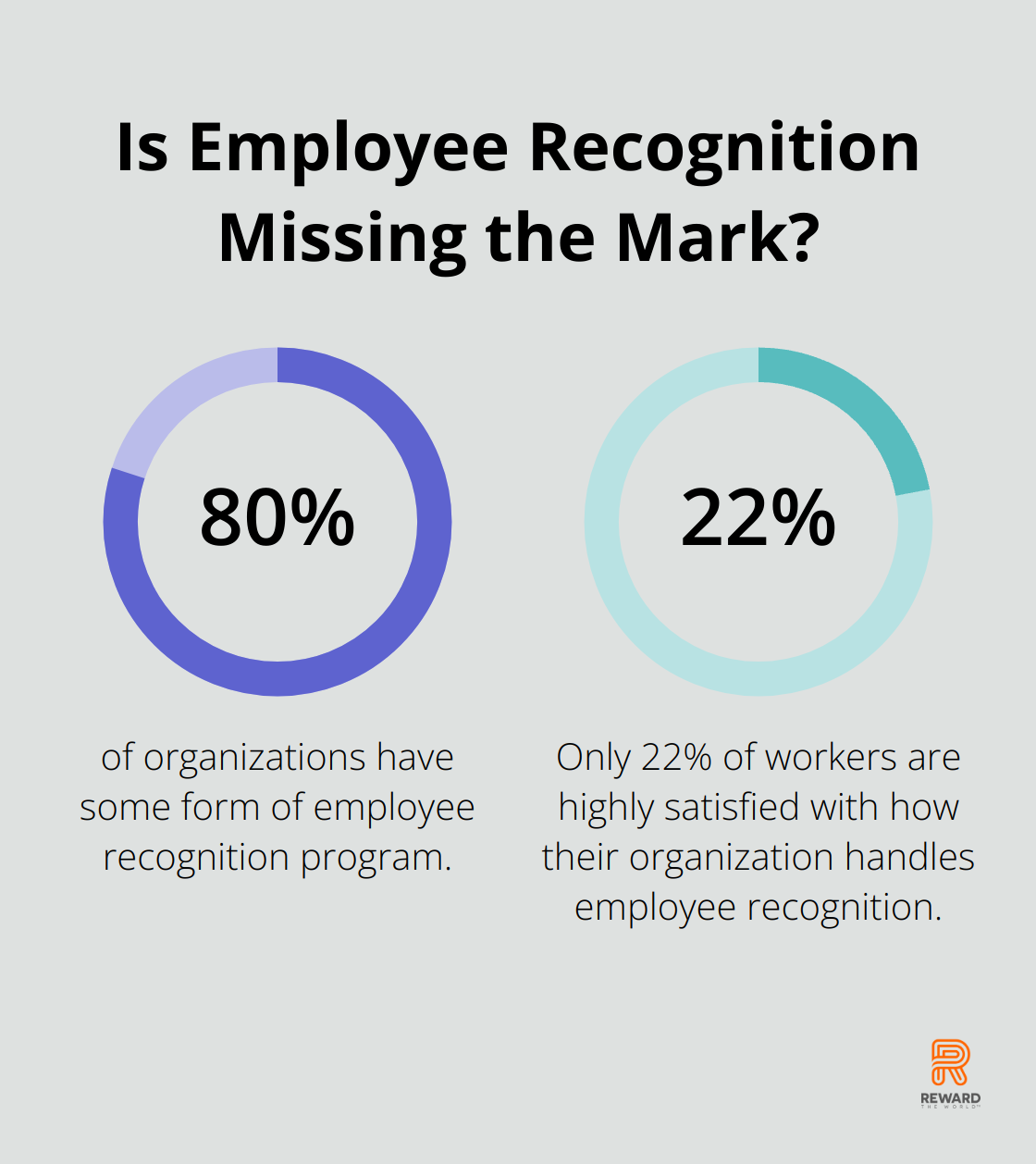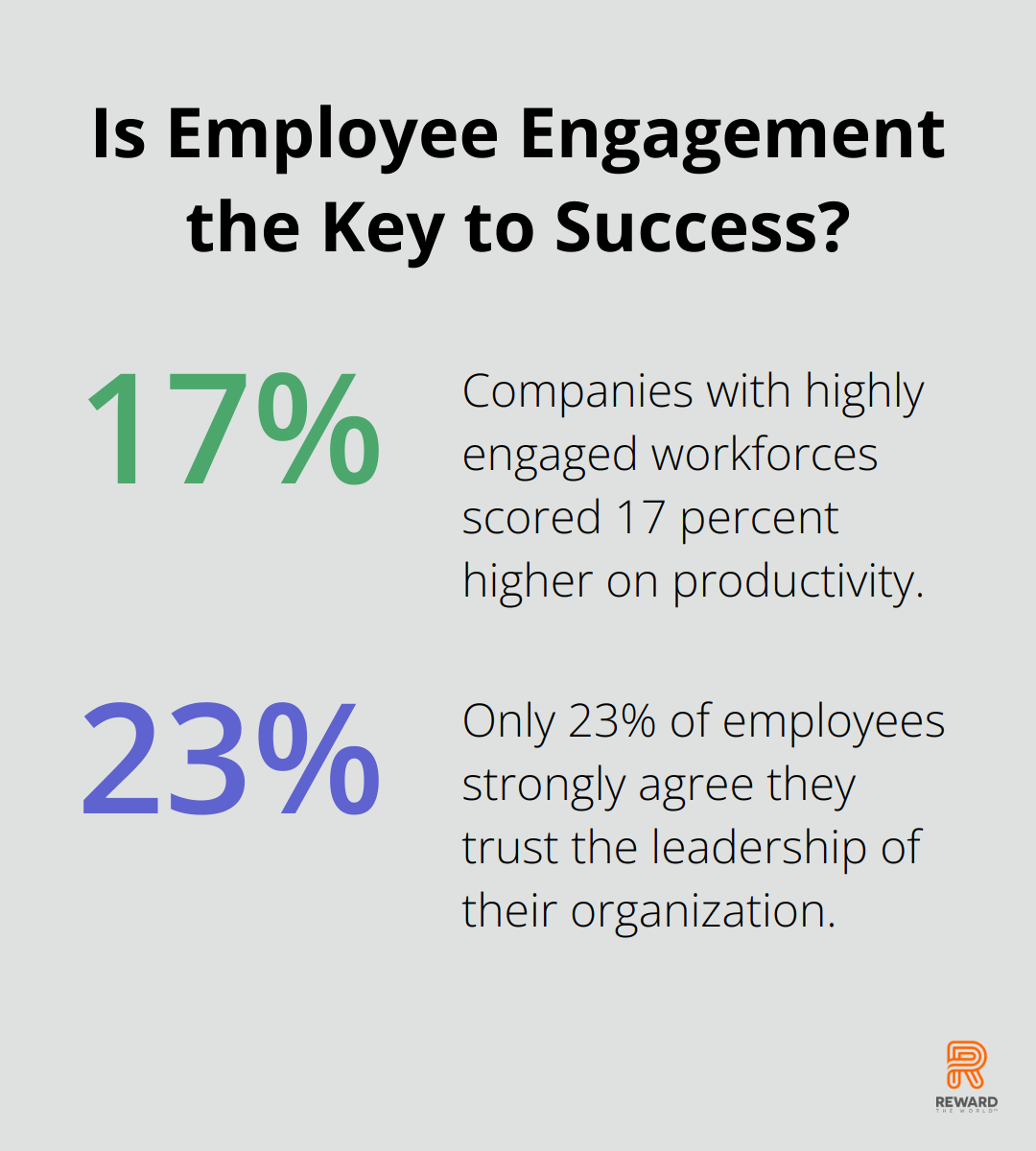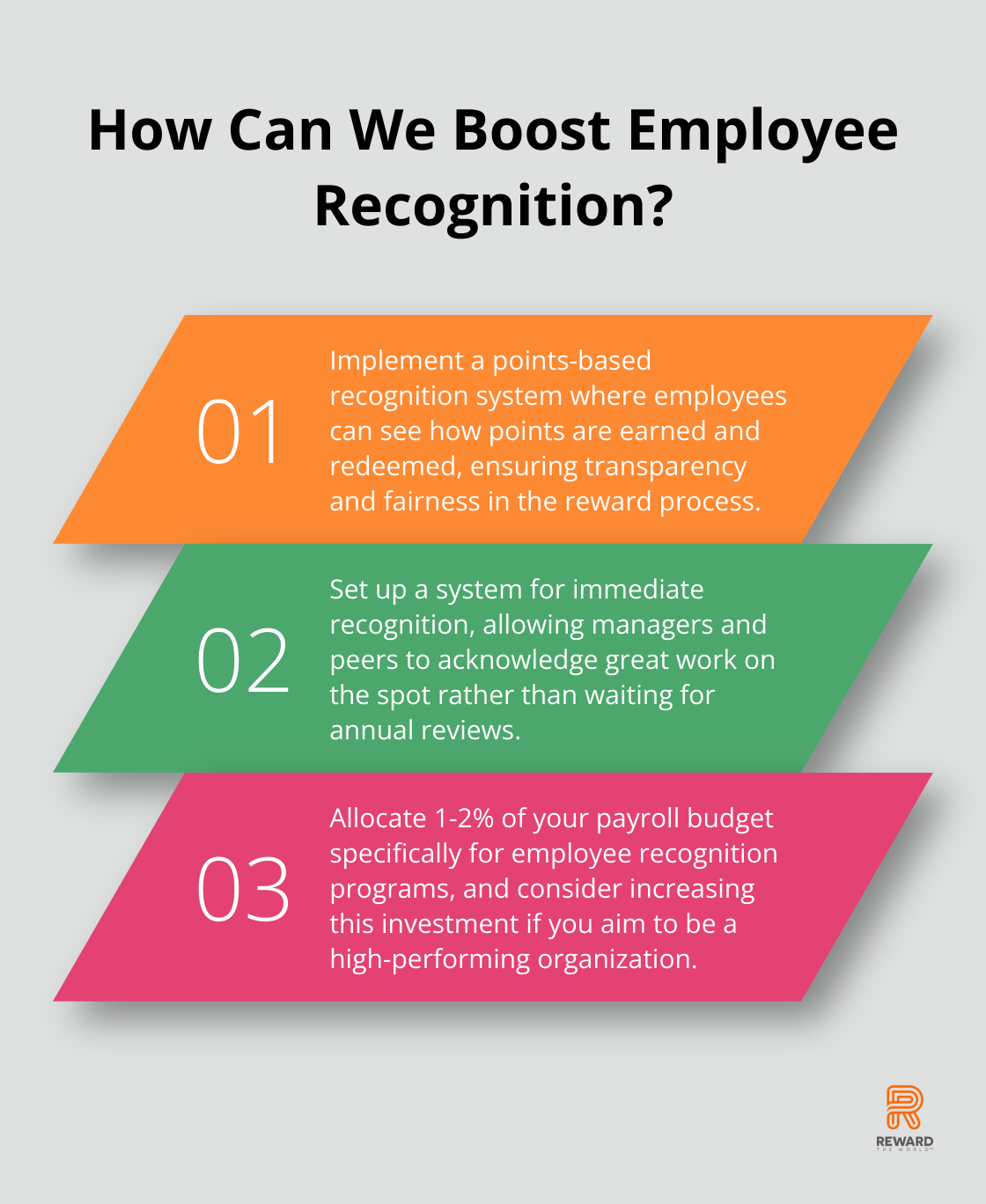
Employee recognition is a powerful tool for boosting morale and productivity. At Reward the World, we’ve seen firsthand how best-in-class reward and recognition programs can transform workplace culture.
This guide will explore various types of employee rewards, key elements of successful programs, and practical steps for implementation. We’ll share insights to help you create a recognition strategy that aligns with your company’s values and goals.
What Are the Best Employee Reward Programs?
At Reward the World, we’ve observed numerous reward programs in action. The most effective ones combine various types of recognition to address diverse employee preferences and motivations. Here’s a breakdown of the top reward categories that consistently drive engagement and performance.
Cash Bonuses and Salary Increases
Money speaks volumes and often serves as the most straightforward way to show appreciation. Performance-based bonuses, profit-sharing schemes, and merit-based salary increases motivate employees powerfully. A study by WorldatWork touches on strategic approaches to providing flexibility in total rewards and provides benchmarks for the prevalence of programs and practices. However, these monetary rewards must link to clear, achievable goals to maintain their impact.
Experiential Rewards
Non-monetary recognition can match the impact of cash rewards. Experiential rewards like team outings, concert tickets, or travel vouchers create lasting memories and strengthen team bonds. The Incentive Research Foundation found that 84% of U.S. businesses use non-cash rewards, with travel incentives proving particularly effective for long-term motivation.
Career Advancement Opportunities
Professional development rewards continue to give. Offering leadership training, mentorship programs, or funding for advanced certifications demonstrates investment in your employees’ futures. Google’s “20% time” policy (allowing employees to spend one day a week on side projects) has led to innovations like Gmail and AdSense while boosting job satisfaction.
Flexible Work Arrangements
Work-life balance initiatives have gained significant value, especially post-pandemic. Flexible hours, remote work options, or additional paid time off can boost employee satisfaction substantially. A study by Gartner found that performance improves in part because radical flexibility provides employees with a much-needed sense of autonomy, and in part because it allows for better work-life balance.
Peer-to-Peer Recognition Programs
Empowering employees to recognize each other’s contributions creates a culture of appreciation. Platforms like Reward the World simplify the implementation of peer recognition systems, allowing colleagues to award points or badges for great work. This approach not only boosts morale but also reinforces company values at a grassroots level.
Wellness Programs
Investing in employee health yields dividends in productivity and reduced healthcare costs. Wellness rewards might include gym memberships, mental health resources, or fitness challenges with prizes. Johnson & Johnson’s wellness program reportedly saved the company $250 million on health care costs over a decade.

Implementing a mix of these reward types ensures you cater to different employee preferences and motivations. The key lies in aligning your reward program with your company culture and objectives while providing meaningful recognition that resonates with your team. Now, let’s explore the essential elements that make these reward programs truly successful.
What Makes a Reward Program Successful?
At Reward the World, we’ve observed numerous reward programs in action. The most effective ones share key elements that set them apart. Let’s explore these essential components that transform a good reward program into a great one.
Set Clear Goals and Track Progress
Successful reward programs start with well-defined objectives. You should pinpoint your aims: boost productivity, improve retention, or enhance customer service. Once you’ve identified your goals, establish measurable metrics. For instance, if you target improved customer service, track Net Promoter Scores (NPS) or customer satisfaction ratings. A study found that organizations with sophisticated recognition programs are 12 times more likely to have strong business outcomes.
Ensure Fairness and Transparency
Employees need to trust the reward system. Make the criteria for rewards crystal clear and apply them consistently across all levels. Transparency builds trust. Consider using a points-based system where employees can see how points are earned and redeemed. Gallup reports that when employees strongly agree that their company’s recognition program is fair, they’re 2.6 times more likely to be highly engaged at work.
Recognize Promptly
Timely recognition amplifies its impact. Don’t wait for annual reviews to acknowledge great work. Implement tools that allow for immediate recognition. The Society for Human Resource Management (SHRM) found that 80% of organizations have some form of employee recognition program, but only 22% of workers are highly satisfied with how their organization handles it. Prompt recognition can bridge this gap.
Personalize the Experience
One size doesn’t fit all when it comes to rewards. Offer a variety of options to cater to different preferences. Some employees might value extra time off, while others prefer professional development opportunities or tangible rewards. Try to implement a system that allows employees to choose from a range of rewards that align with their interests and motivations.
Evolve and Adapt
The most successful reward programs don’t remain static. Regularly gather feedback from your employees and adjust your program accordingly. This continuous improvement process ensures your program stays relevant and effective. (It’s worth noting that employee preferences can change over time, so what works today might need tweaking tomorrow.)

Now that we’ve covered the key elements of successful reward programs, let’s move on to the practical steps of implementing these strategies in your organization.
How to Implement an Effective Recognition Program
Analyze Your Current Culture
Start with an assessment of your existing company culture. Survey your employees to understand their recognition preferences. Ask specific questions like: “What types of rewards motivate you most?” This data will form the foundation of your program.
Companies with highly engaged workforces scored 17 percent higher on productivity. Your recognition program should address these challenges directly.
Define Clear Objectives and Budget
Establish specific, measurable goals for your recognition program. Do you want to increase employee retention by 20%? Boost productivity by 15%? Improve customer satisfaction scores by 10 points? These concrete objectives will guide your program design and help measure its success.

Allocate a budget that reflects the importance of employee recognition. Companies typically spend 1-2% of payroll on recognition programs. However, high-performing organizations often invest more, viewing it as a strategic tool rather than an expense.
Select Rewards That Resonate
Pick rewards that align with your company values and employee preferences. Combine monetary and non-monetary rewards for maximum impact. For instance, mix performance bonuses with experiential rewards like team outings or professional development opportunities.
A wide array of reward options, from e-gift cards to charitable donations, caters to diverse employee preferences. This flexibility ensures your program resonates with all team members.
Equip Your Managers
Your frontline managers play a key role in the success of your recognition program. Provide thorough training on how to effectively recognize employees. Teach them the importance of timely, specific praise and how to use your chosen recognition tools.
A recent Gallup poll found that only 23% of employees strongly agree they trust the leadership of their organization. Bridge this gap by empowering your managers to become recognition champions.
Continuously Improve
Launch your program, but don’t consider it finished. Collect feedback regularly from both employees and managers. Use this data to refine and improve your recognition strategies.
Try implementing a quarterly review process. Analyze key metrics like employee engagement scores, retention rates, and productivity indicators. If you use a recognition platform, leverage its analytics tools to gain deeper insights into program performance.
The most effective recognition programs evolve with your organization. Stay flexible and prepare to adapt your approach based on changing business needs and employee feedback.
Final Thoughts
Effective employee reward and recognition programs foster a positive work environment and drive organizational success. We explored various strategies, from monetary incentives to experiential rewards, and highlighted the importance of clear objectives, fairness, timeliness, and personalization in program design. The key to implementing best-in-class reward and recognition programs lies in tailoring them to your unique company culture.

Employee recognition programs extend far beyond short-term productivity gains. They contribute to long-term employee satisfaction, improved retention rates, and a more positive workplace culture (these programs can transform your organization, fostering loyalty and driving innovation). Investing in employee recognition is an investment in your company’s future.
Reward the World offers a comprehensive platform that simplifies the implementation of recognition programs. We provide a wide range of reward options to suit diverse employee preferences. Start today, and watch as your workplace transforms into a hub of motivation, engagement, and achievement.
